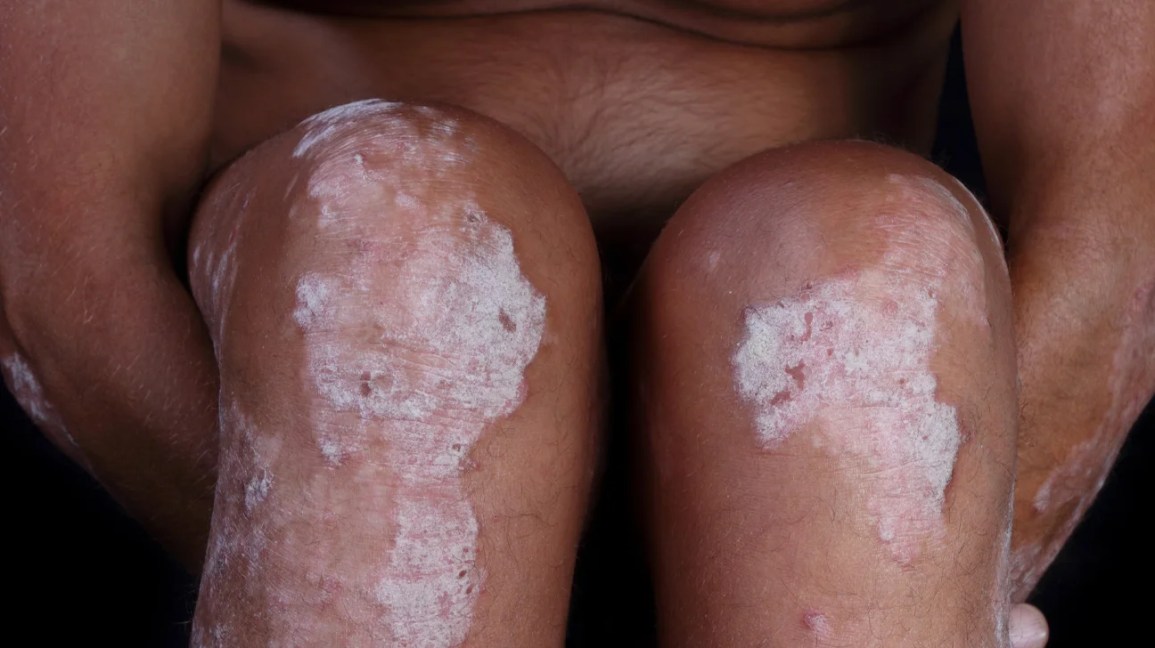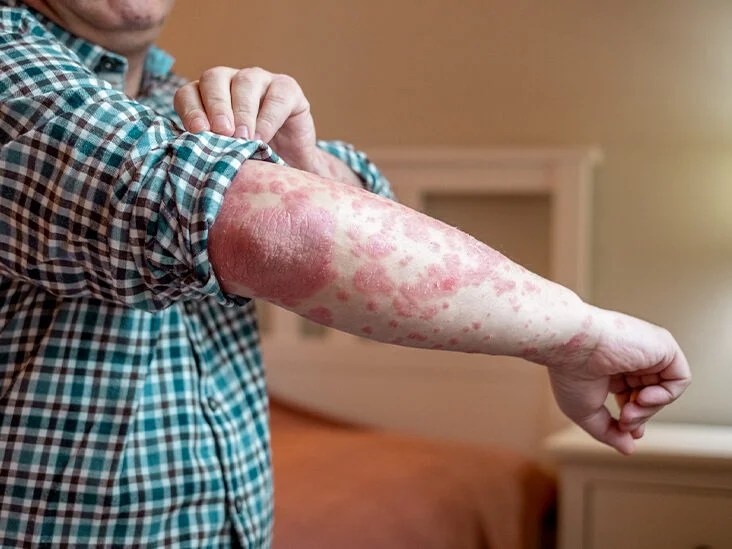Psoriasis
Psoriasis is an immune-mediated disease, meaning that a dysfunctional immune system is a key cause of the disease. In the case of psoriasis, an overactive immune system can cause a rapid increase in skin cell production that leads to raised, scaly patches on the skin.

Image: Scalp psoriasis (iStock)
Download PDF here.
About Psoriasis
Psoriasis is a skin disease that results in localized, thickened, and scaly patches on the skin ("plaques"). The color of the plaques depends on the skin type. Psoriasis in light skin appears red/pink, while in skin of color, it may appear brown or purple. The scaling on the plaque is usually white or silvery.
THE SEVERITY varies greatly from person to person. For some it's just a minor irritation, but for others it can have a big impact on their quality of life.
PSORIASIS IS A CHRONIC disease that usually involves periods when you have no symptoms or mild symptoms, followed by periods when symptoms are more severe.
THE DIAGNOSIS is made by a doctor, usually a general practitioner or dermatologist, based on the appearance of your skin. Usually, no further tests are needed, but if the doctor is unsure, a small skin sample (biopsy) of the rash may be taken.
Causes
The cause of psoriasis is complex and not yet fully understood, but we know that the immune system, genetics and environment play major roles in its development. One thing we do know: psoriasis is not contagious. You cannot catch psoriasis from another person. Usually, something triggers psoriasis, causing symptoms to appear or worsen. Triggers vary from person to person. Possible triggers include streptococcal throat infection, stress, skin injuries/irritation (Koebner phenomenon), or hormonal changes.
Symptoms and localization
Psoriasis typically causes patches of skin that are dry and covered in scales. Some people find their psoriasis causes itching or soreness.
There are several different types of psoriasis, each with a slightly different set of symptoms and locations. Some types are more common than others, and individuals may have multiple types simultaneously.
- Plaque psoriasis (images) is the most common form in adults and is characterized by distinct patches often located on the scalp, elbows, and knees.
- Scalp psoriasis (images) is a type of plaque psoriasis. It can occur on parts of your scalp or on the whole scalp. It causes patches of skin covered in thick scales.
- Guttate psoriasis (images) is the most common form in teenagers and young adults and sometimes occurs after a streptococcal throat infection. This type of psoriasis often starts suddenly and causes small drop-shaped sores on your chest, arms, legs and scalp. Some people go on to develop plaque psoriasis.
- Inverse (flexural) psoriasis (images) affects folds or creases in your skin, such as armpits, groin, between the buttocks and under the breast. It can cause large, smooth patches of skin in some or all these areas.
- Nail psoriasis (images) can occur with all types of psoriasis and causes changes in the nails. These changes range from tiny dents or pits, to thickening, and discoloration of the nails. The nails can also become loose and separate from the nail bed.
Inflammation caused by psoriasis can impact other organs and tissues in the body. People with psoriasis may also experience other health conditions, a phenomenon called comorbidities. Psoriasis is particularly associated with an increased risk of cardiovascular disease, diabetes, anxiety, depression, and metabolic syndrome. 10-15 % of those with psoriasis also experience joint pain (psoriatic arthritis).


Images: Plaque psoriasis on knees and arm (iStock)
Prevalence
It is estimated that 3.8-4.6 % of the population has psoriasis in Norway (2023)¹. Symptoms often start between ages 15 and 25 but can occur at any age. It affects men and woman equally.
Prognosis and Treatment
There is no treatment that can cure psoriasis, but with the right treatment, symptoms can be reduced so that the disease is less intrusive in daily life.
TREATMENTS are determined by the type and severity of your psoriasis. A wide range of treatments are available for psoriasis, but identifying the most executive one can be difficult. The treatment often starts with local treatment (step 1), and if these treatments is not effective enough or cannot be used, the next treatment step in treatment is pursued.
STEP 1: Local Treatment
- Removal of scales
- Medicinal baths
- Topical: creams, ointments, foams, gels, liniments, solutions, shampoos, etc.
STEP 2: Phototherapy
- Medical light therapy (UVB/PUVA)
- Climate therapy (read more here)
STEP 3: Systemic
- Non-biological disease-modifying drugs
STEP 4: Immunomodulators
- Biological medicine
- Biosimilar medicine
Read more about the treatment of psoriasis her (in Norwegian).
A life with psoriasis
Although psoriasis is just a minor irritation for some people, it can significantly impact quality of life for those more severely affected. Psoriasis may affect your emotional health, your relationships, and how you handle stress. It could even affect areas of your life that you wouldn’t expect, such as the clothes that you choose to wear.
COMPENSATION SCHEMES. Individuals with chronic skin conditions can receive subsidies for moisturizing agents and over-the-counter drugs. To receive reimbursement from the National Insurance Scheme, you must first apply for inclusion in the scheme, which must be done by your dermatologist.
Read more about your rights and reimbursement options here!
WORK CAPACITY AND ACCOMMODATION. Most people with psoriasis can function in a work situation if conditions are adapted to it. Adaptation is the responsibility of the employer, and in consultation with the doctor, your workplace should be adjusted to your abilities as much as possible.
Do you have any questions about your rights as an individual with a chronic illness? Call the The Norwegian Federation of Organizations of Persons with Disabilities (FFO) Rights center Tel. +47 23 90 51 55.
